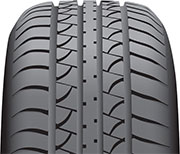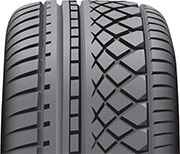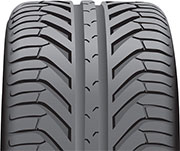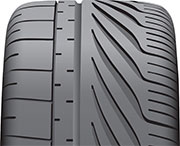There are different types of tyre tread patterns to adapt to different purposes that they can serve on road. The four most common tyre tread designs are symmetrical, asymmetrical, directional, and asymmetrical & directional.
SYMMETRICAL TREAD

A symmetrical tread pattern is the most common tread design in the industry. The inner and outer tread blocks feature the same pattern. Symmetrical tyres can be rotated to any position on the vehicle which helps prevent uneven tread wear. Some symmetrical tyres have the options of whitewall, blackwall, and raised white letters that differ on each side giving the choice of what style of sidewall to display.
ASYMMETRICAL TREAD

Asymmetrical tread design has different features on the inner and outer tread areas. Many tyres are designed where just the tread patterns are different, while other asymmetrical tyres feature different rubber compounds on the inner and outer tread to provide enhanced grip and handling. Generally, one section of tread will provide all-season capabilities, while other sections provide a quiet ride and handling.
DIRECTIONAL TREAD

Directional tyres are designed with the tread pattern angled to point in one direction. The tread design is typically V-shaped and is more resistant to hydroplaning. The tread blocks are molded diagonally to push away water from the contact patch more effectively. Directional tyres cannot be rotated from one side of the vehicle to the other side, they can only be rotated front to back – which can often lead to more road noise as they wear. The tyres would be mounted: two tyres for one direction (driver’s side) and the other two tyres in the opposite direction (passenger side).
ASYMMETRICAL & DIRECTIONAL TREAD

Asymmetrical and directional tyres are designed as a combination of the two tread designs. This tread pattern is very uncommon and is typically found in the ultra-high performance category. These tyres can only be mounted one way and will be designated as either right side or left side tires for your vehicle. As long as the tyres are not staggered, they can be rotated front to back. If the vehicle has staggered fitment the tyres must remain in the same position for the duration of their life.

